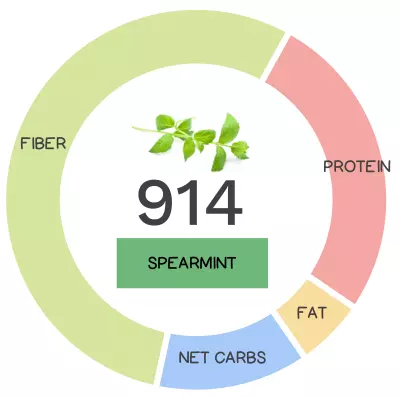
Spearmint is one of the most fragrant, and delicious herbs out there, and can jazz up anything from a summer mojito to holiday baking, and everything in between! Before we get to the nutrients in this amazing herb, there’s so much more to “mint-ion”!
Mint is typically used as a flavoring in foods and steeped in hot water as an herbal tea.
Mint is an herbaceous plant native to Europe and southern Asia, yet is naturalized and grown readily in most temperate parts of the world, making it a very attainable and accessible food resource. The parent species mentha comprises over 25 different hybrid species, and combined with further sub species has seen over 3,000 unique names published for the variety of cultivars. Mint is most used as an ingredient to flavor foods and steeped in hot water as an herbal tea. Additionally, the oil of mint plants can be used for essential oil uses such as scents, concentrated flavoring, and has been used in traditional medicine for generations.
The mint herb is generally known to be only the leaves of the mint plant. The plant has serrated leaves which are grown in opposite pairs on the square-shaped stem, and leaf colors can range from gray-green, purple, blue, light yellow and dark green. It is a perennial plant that grows well in many climates and is spread by runners (underground rhizomes) that grow quickly. In certain countries it is even classified as an “invasive species” to prevent rampant spreading. As a result, most gardeners typically opt for cultivating in pots or planters to limit its spread. Mint plants typically thrive in full sun to partial shade, with plenty of moisture in well-draining soil.
Mint is easily grown all over the world in temperate climates and propagates so easily it can quickly become invasive.
Spearmint is a particular hybrid species of the mint family that is known as mentha spicata. However, mentha spicata can be further hybridized with other species to create many other subspecies. In short, the combinations of mentha species are numerous, confusing and all very similar, yet unique in their own right! It’s a family tree that would even confuse Ancestry.com.
The spearmint plants flower between July and September in the northern hemisphere and are named for its spear-shaped pointed leaf tips. Unlike its peppermint relatives, oil of spearmint is used in many concentrated flavorings for toothpaste, candy, and is even added to shampoos and soaps thanks to its small amounts of menthol and menthone. Menthol and menthone offer unnecessary analgesic and cooling properties you might not seek out in Christmas baking, for instance.
Spearmint is named for its spear-shaped pointed leaf tips.
Spearmint has also been used successfully as a larvicide (i.e. it kills the larvae that has been laid) against mosquitoes, and an insecticide against moths, which is a far greener alternative to other toxic synthetic insecticides. With its quick-growing, easily propagated and diverse usage, it’s no wonder this herb is so well known and used all over the world. You could say it was simply, “mint” to be!
Nutrivore Score for Spearmint – 914
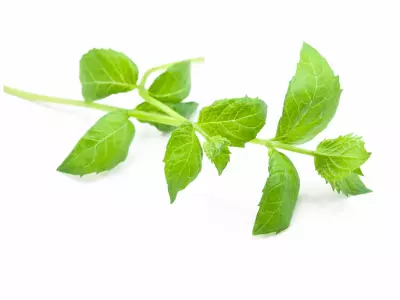
Spearmint has a minimum Nutrivore Score of 914, making it a super nutrient-dense food! Plus, it is a low-carb and low-calorie-density food; the calorie count of spearmint is only 40 calories per cup!
Per serving, spearmint is a good source (10-20% daily value) of iron, manganese, and polyphenols.
Ditch Diets. Embrace Nutrients. Start with this FREE Guide.
Sign up for the free Nutrivore Newsletter, your weekly, science-backed guide to improving health through nutrient-rich foods — without dieting harder —and get the Beginner’s Guide to Nutrivore delivered straight to your inbox!
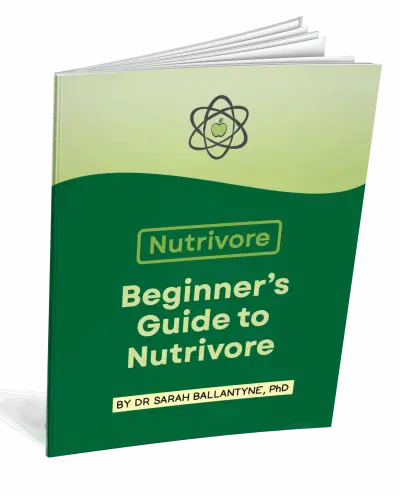
Spearmint Nutrition Facts
One serving of fresh spearmint is standardized to 1/4 cup of fresh spearmint or about 22.8 grams (0.8 ounces). For herbs, on average, three parts fresh is roughly equivalent to 1 part dried, so if using dried spearmint: 1 tablespoon fresh spearmint is equivalent to 1 teaspoon dried spearmint.
Spearmint Nutrition Facts Per Serving
| Spearmint, fresh | Nutrivore Score: 914* | Nutrient Density: Super! |
|---|---|---|
| Serving Size: 1/4 cup (22.8 grams) | Protein: 0.8 grams | Net Carbohydrates: 0.4 grams |
| Calories: 10 | Total Fat: 0.2 grams | Dietary Fiber: 1.6 grams |
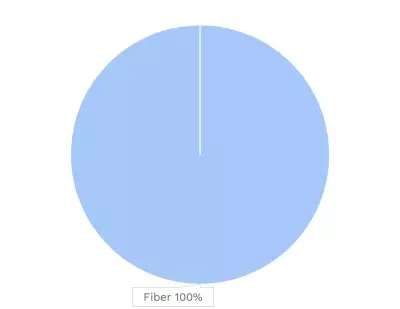
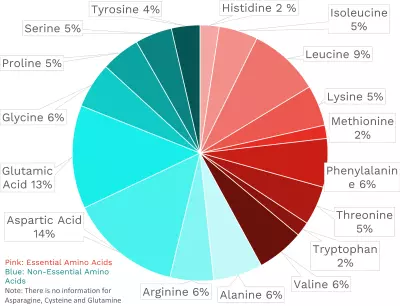
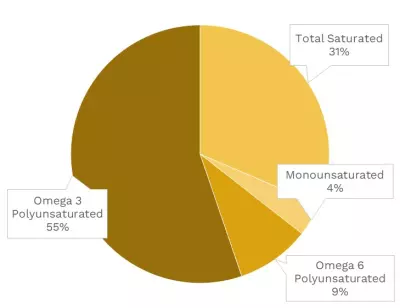
| VITAMINS | ||
|---|---|---|
| Vitamin A | 46.3 μg RAE | 5% DV |
| Vitamin B1 (Thiamin) | 17.8 μg | 1% DV |
| Vitamin B2 (Riboflavin) | 39.9 μg | 3% DV |
| Vitamin B3 (Niacin) | 0.2 mg | 1% DV |
| Vitamin B5 (Pantothenic Acid) | 0.1 mg | 1% DV |
| Vitamin B6 (Pyridoxine) | 36.0 μg | 2% DV |
| Vitamin B7 (Biotin) | ~ | ~ |
| Vitamin B9 (Folate) | 23.9 μg | 6% DV |
| Vitamin B12 (Cobalamin) | 0.0 μg | 0% DV |
| Vitamin C | 3.0 mg | 3% DV |
| Vitamin D (D2 + D3) | 0.0 μg | 0% DV |
| Vitamin E | ~ | ~ |
| Vitamin K | ~ | ~ |
| Choline | ~ | ~ |
| Myo-Inositol | ~ | ~ |
| CoQ10 | ~ | ~ |
| FUNCTIONAL FATS | ||
|---|---|---|
| MUFA | 0.0 g | 0% DV |
| ALA | 77.1 mg | 5% DV |
| EPA + DHA | ~ | ~ |
| CLA | ~ | ~ |
| Linoleic Acid | 0.0 g | 0% DV |
| MCT’s | ~ | ~ |
| MINERALS | ||
|---|---|---|
| Calcium | 45.4 mg | 3% DV |
| Copper | 54.7 μg | 6% DV |
| Iodine | ~ | ~ |
| Iron | 2.7 mg | 15% DV |
| Magnesium | 14.4 mg | 3% DV |
| Manganese | 254.9 μg | 11% DV |
| Phosphorus | 13.7 mg | 1% DV |
| Potassium | 104.4 mg | 2% DV |
| Selenium | ~ | ~ |
| Sodium | 6.8 mg | 0% DV |
| Zinc | 0.2 mg | 2% DV |
| PHYTONUTRIENTS | ||
|---|---|---|
| Carotenoids | ~ | ~ |
| Polyphenols | 91.2 mg | ~ |
| Phytosterols | ~ | ~ |
| Glucosinolates | ~ | ~ |
| Thiosulfinates | ~ | ~ |
| Betalains | ~ | ~ |
| AMINO ACIDS & PEPTIDES | ||
|---|---|---|
| Taurine | ~ | ~ |
| Ergothioneine | ~ | ~ |
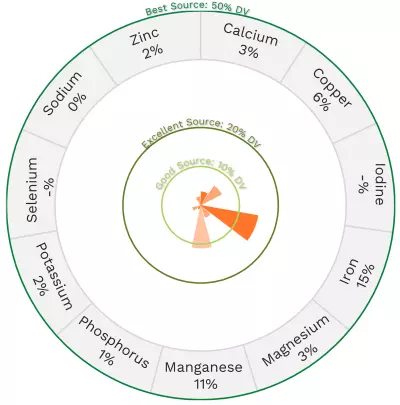
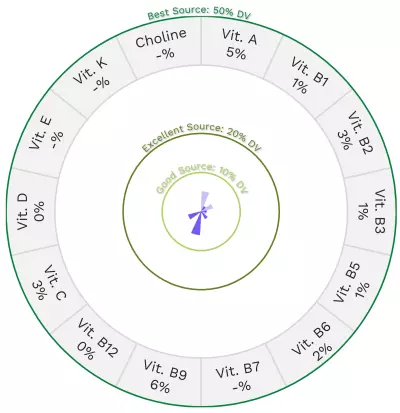
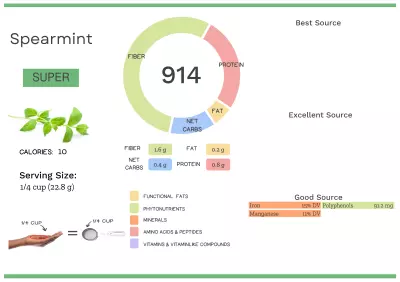
Spearmint Nutrition Varies With Processing
The Nutrivore Score for spearmint varies depending on processing. For instance, dried spearmint is conveniently available year-round and is a simple and easy way to boost the nutrient density of any meal!
| NUTRIVORE SCORE | |
|---|---|
| Spearmint, dried | 13361 |
| Spearmint, fresh | 9141 |
Mint Nutrition Varies With Variety
There are countless different types of mint, each with its own unique flavor and nutrient profile, which means their Nutrivore Scores vary too. Try incorporating different types into your diet to maximize all the nutrition mint has to offer.
| NUTRIVORE SCORE | |
|---|---|
| Peppermint, fresh | 10111 |
| Spearmint, fresh | 9141 |
Impressed by the unbe-LEAF-able nutrition in spearmint? Maybe your friends will be too!
Want to know the top 500 most nutrient-dense foods?

Top 500 Nutrivore Foods
The Top 500 Nutrivore Foods e-book is an amazing reference deck of the top 500 most nutrient-dense foods according to their Nutrivore Score. Think of it as the go-to resource for a super-nerd, to learn more and better understand which foods stand out, and why!
If you are looking for a quick-reference guide to help enhance your diet with nutrients, and dive into the details of your favorite foods, this book is your one-stop-shop!
Buy now for instant digital access.
How Much Spearmint Should We Eat Per Day?
Herbs (like spearmint) are often solely used as garnish but in actuality provide the perfect opportunity to deliver a health-promoting boost of flavor and nutrients to any dish.
The health benefits attributed to herbs and spices, and particularly their phytonutrient content and volatile oils, are incredibly vast. In general, herbs and spices have been shown to have powerful antioxidant activity, exhibit anti-cancer effects (especially due to polyphenols, terpenes, vanilloids, and organosulfur compounds), reduce inflammation (for example, basil, bay leaves, sage, thyme, licorice, and oregano have been shown to improve cytokine profiles), and reduce cardiovascular disease risk.
There is evidence from human clinical trials showing that adding spices and herbs to our diet can improve serum lipid profiles (HDL cholesterol, LDL cholesterol and triglycerides) as well as glycemic control, blood pressure, inflammation, and oxidative stress. For example, a 2022 study added a mere 6.6 grams per day per 2100 calories of herbs and spices (that’s about a teaspoon of seasonings throughout the whole day) to the diets of adults with risk factors for cardiovascular disease, with a crossover design comparing to a 3.3 grams of herbs and spices phase as well as a <0.5 grams herbs and spices phase. After four weeks consuming the higher level of herbs and spices, the participants had significant improvements in gut microbiome composition including growth of bacteria associated with reduced cardiovascular disease risk. A 2021 study by the same research group showed reductions in blood pressure after a single day of higher intake of herbs and spices. And a follow-up 2022 study showed reduced markers of inflammation after four weeks of the higher spice intake diet, including reduced fasting plasma IL-6 and postprandial plasma IL-1β, IL-8, and TNF-α. All in all, this makes a compelling case for aiming for a teaspoon of dried herbs and spices (or 1 tablespoon fresh) or more per day added to our meals! Learn more about herbs and spices here.
Mint, including peppermint and spearmint, has demonstrated a number of health benefits—especially when it comes to gastrointestinal health! Since the health benefits attributed to herbs (like spearmint) are credited to the diverse array of phytonutrients and volatile oils found within different herbs and spices, it is important that we strive for variety when incorporating these foods in our diet. Not only when it comes to herbs, but in general it’s always best to mix up the veggies you eat day to day (aiming for a wide variety of different vegetables and fruits throughout the week).
Easily track your servings of Nutrivore Foundational Foods!

The Nutrivore Weekly Serving Matrix
The Nutrivore Weekly Serving Matrix digital resource is an easy-to-use and flexible weekly checklist designed to help you maximize nutrient-density and meet serving suggestions of Nutrivore foundational foods, all without having to weigh or measure your foods!
Includes a 22-page instructional guide and downloadable interactive guides.
Buy now for instant digital access.
cITATIONS
Expand to see all scientific references for this article.
Phenol-Explorer: Spearmint, fresh
USDA Food Central Database: Spearmint, fresh


